WildSnow Beacon Reviews Intro and Index
By Caleb
Beacon guru Jonathan Shefftz provided Wildsnow readers with a thorough review of the Peips DSP & DSP Advanced last February. Not much I can add, so the purpose of this post is to share some personal experiences with our DSPs and delve a little farther into the Pieps iProbe.
Pieps DSP
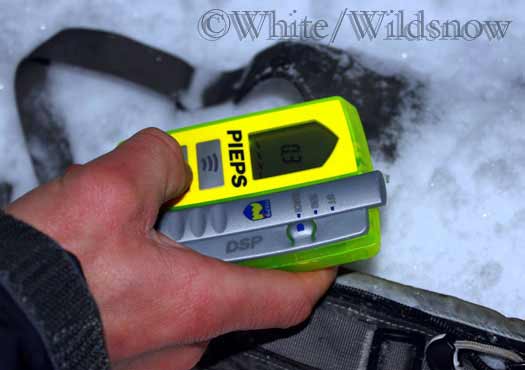
The Pieps DSP Avalanche Beacon
My wife and I decided in December of 2007 that it was time for a beacon upgrade. After putting in our time scouring the internet, popping into a few local shops, and tapping the combined wisdom of our friends, we settled on the Pieps DSP. Major reasons? The user interface was simple and straight forward, 3 antenna digital simplifies rescue, and there appeared to be a commitment from Pieps to constantly refine the firmware. This meant that we wouldn’t be left with old technology in just a few years.
Firmware
The firmware commitment turned out to be a fact. Since purchasing our beacons with firmware version 4.0, Pieps has released 2 firmware upgrades, the latest being version 6.2. You can check out the new bells and whistles with firmware 6.2 here.
So how do you get the latest firmware version? Simple, find your nearest Pieps service center, swing by or mail in your beacon, and they can usually have the upgrade completed in minutes. We get ours updated by our friends down at Bent Gate Mountaineering. The cost for the service is around $20, not a nominal sum, but certainly cheaper than a new beacon. I consider the price to be reasonable, but it would be more convenient if we could just download the upgrades ourselves. I can browse Wildsnow.com and the CAIC report almost simultaneously, I feel ready to take on a self download.
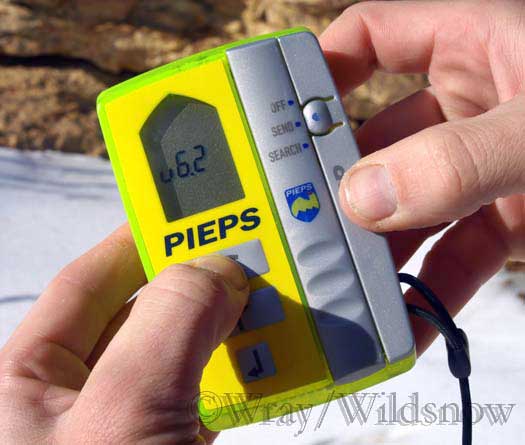
To check the latest firmware on your Pieps DSP, move the mode switch from OFF to SEND while simultaneously holding down the SCAN button. The firmware version will be displayed on the screen.
Personal Pieps DSP Experience
Mr. Shefftz did a superior job of hammering out the DSP facts. So I figured I would add some practical observations since my wife and I have used the DSP in the field over 200 days so far. And I must confess, I play beacon hide and go seek with the fervor that the youngsters play Wii.
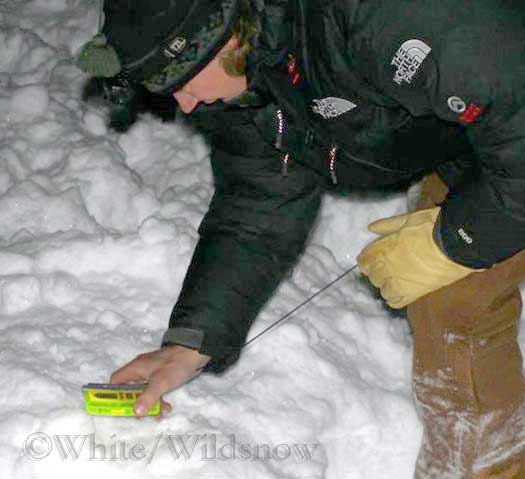
The author during moonlight beacon practice.
Here are a few of my experiences and opinions as they relate to the Pieps DSP:
* My DSP has a fairly long range in comparison to many other popular beacons. I can usually pick up a signal 50-60m away.
* The direction arrows and distance indicators are less reliable when at the outer limits of the beacon’s search range. I have observed this same issue with other models.
* By contrast, I always trust the display when indicated to be within 20 meters of the victim. It has yet to lead me wrong inside this distance. My own head has however.
* Don’t move too fast when searching. I can easily out run the DSP’s ability to update (true for other models as well). The DSP has an audible sound that accompanies updated location information. With practice, my search pace now moves in time with the beep like a metronome.
* The DSP has 5 directional arrows, 1 points straight ahead with two additional on either side. If the straight ahead arrow or the arrows immediately left and right are displayed, move forward. If one of the outermost two arrows are displayed, I stop and turn slowly in that direction until I get back to the middle three. I have found this to be the most efficient strategy for me.
* When I have loaned my Pieps DSP to 3 separate newbie friends and run them through a single burial scenario, they have surprisingly been able to pinpoint the victim on the first attempt in a reasonable time frame with little confusion.
* When allowing those same friends to go through a second scenario with two other popular models, it hasn’t gone as smoothly.
* It is okay to use your friends as guinea pigs as long as they aren’t harmed or named on the internet. You should also pay them with advice, whether they request it or not.
* Don’t be cheap. Get a 3 antenna beacon. It does make a difference.
* Don’t be cheap. Get the firmware upgraded. It does make a difference.
* Don’t waste money. No need for the DSP Advanced. Having an altimeter, thermometer, and compass on a beacon is not convenient or worth $100.
* I have been able to “mark” every located beacon in multiple burial scenarios with one exception, a certain well used Barryvox Opto 3000. Two different Pieps DSPs were unable to mark this beacon until it was dug up and placed within inches of the Pieps. A Barryvox Pulse marked it on the first try on the same burial. Hard to definitively say what the issue was, Pieps or said Barryvox. But others have reported a few instances of the DSP having some sporadic marking issues.
* I don’t worry much about spikes during deep burials anymore.
* Be careful when in “search” mode, there is not a position lock as when in “send” mode. On a few occasions, I have totally blown multiple burial and search scenarios by stuffing my DSP back into my pocket to assemble a probe or shovel, only to find that it slipped back into “send” mode. Confusion ensued.
* A zipped pocket on my pants is a better place for my Pieps than the provided silver harness. It fits perfectly and is hands down more convenient for use.
* The elastic cord that hangs from most beacons is actually really useful. The DSP has a long adjustable one. I always attach it to my pants and now never accidentally bury my beacon. Seems simple but I don’t always see it practiced.
* Cheap plastic food containers are not good housings for buried beacons, probes go through them. And my DSP’s LCD doesn’t like probes.
* Pay attention to the self check on power up. It may be okay 1,000 times in a row, but then show you something is out of place on power-up 1,001.
* Battery life doesn’t seem as good as some other models, but honestly, unless I forget to turn it off when I get back to the truck, 3 AAA’s last a long time.
* Extra batteries and a tool that can remove the wide mouth screw on the battery cover are good to keep on hand. As I tend to forget to turn it off when I get back to the truck.
Pieps iProbe
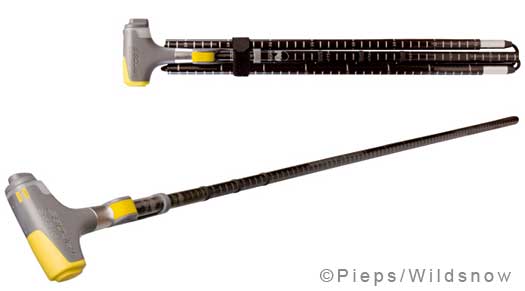
The Pieps iProbe, shown collapsed and assembled.
I tested the iProbe 225cm (folded length 48cm, weight 290g with battery, price ~$190) a few weeks ago. My first question as I held it in hand was, I wonder how the vitals stack up to my other probes? So I took a look at my BD QuickDraw Carbon 230cm (folded length 41cm, weight 230g, price ~$66) and my BCA Carbon 260cm (folded length 42cm, weight 207g, price ~$80). With that said, I knew there would be weight and wallet sacrifices given the hi-tech functionality of the iProbe.
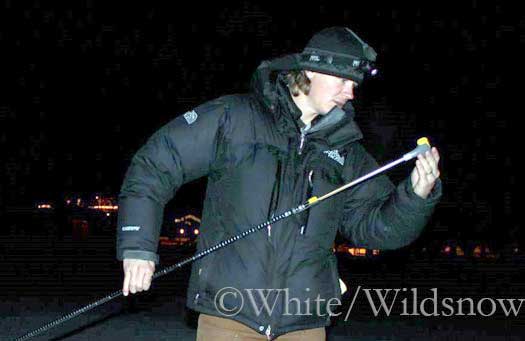
Wow! A probe with buttons.
First Impressions
The sturdiness felt comparable to my BD QuickDraw, which gives me confidence that the probe would penetrate the cement you often find in a debris field. The standard graduated centimeter marks make it useful for identifying burial depth and snow pit work. I only needed a few practice runs to get the feel for efficient assembly and extended lock. The iProbe only takes one AA battery (AAA would be nice considering my other battery powered backcountry gear), and I like the integrated velcro strap to keep things tight and organized in my pack.
So how does it work?
The idea behind the iProbe is to assist in multiple burial situations. Once the initial beacon search identifies the approximate location of the victim, the iProbe helps hone in on the exact location by providing the prober a series of beeps and a pulsed LED illumination on the probe handle. This series of beep and LED indications will occur as long as the victim is sending a signal using any modern beacon. If the victim is using a Pieps Freeride or DSP (w/firmware 5.0 or higher), then the probe has the functionality to temporarily deactivate the found beacon’s transmission signal, making it easier for searchers to focus in on the next strongest signal. This is different than the mark/mask feature on most modern beacons, as the iProbe deactivates the signal for all searching beacons instead of just the searching beacon that performs the mark/mask. This eliminates confusion when there are multiple searchers in a multiple burial situation.
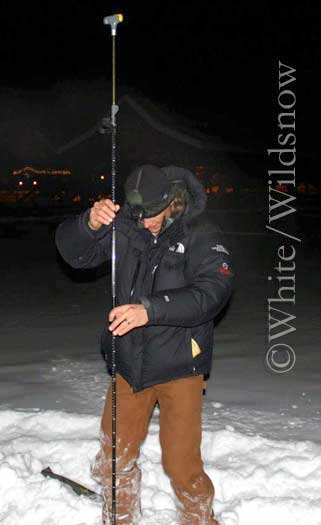
Putting the iProbe to work.
Our Test
We set up a three burial scenario with the victims buried fairly shallow, each with a different model beacon (Pieps DSP, Barryvox Pulse, and Barryvox Opto 3000). The initial search led us to the Pieps and we were quickly able to identify an area, a few meters in diameter, where the victim was buried. The iProbe was assembled, the ON switch was turned, the probe performed a quick self check indicated by a long LED flash and long beep, and then it immediately began sending visual and audible signals to the prober. Once our probe grid got close to the victim’s beacon a continuous beep and LED flash was emitted from the iProbe. By pressing the “mark” button on the opposite side of the handle from the ON switch, the beacon stopped transmitting and was no longer displayed on the search beacon.
In the interest of testing, we removed the snow from the buried Pieps DSP to check the range of the iProbe. As advertised, the probe began signaling when the tip was approximately 2 meters from the beacon. Once within a half meter the continuous signal indicating a strike was given. The iProbe located the other non-Pieps beacons, but was unable to deactivate their transmissions.
Overall Thoughts
Another great innovation from Pieps. Construction is solid, assembly and functionality are easy to master and our simple test indicated the device to work as expected. The elimination of potential missed and false probe strikes would definitely adds value to a search. However it’s clear the greatest advantage of this device is the ability to deactivate the beacon signals on found victims in multi-burial situations.
As others have noted, the obvious beneficiaries of this new technology will likely be larger guided ski operations. These operations have the ability to provide all of their guides and clients with Pieps beacons and iProbes. In these situations, the iProbe would be a valuable piece of safety equipment. Allowing for quick victim location and signal deactivation in a multiple burial situation. Since the iProbe must stay within ~50cm of the found victim’s beacon in order for the transmission signal to remain deactivated, the group would need one less iProbe than the number of victims buried to achieve maximum advantage. Multiple iProbes per guide would probably make the most sense. As well as a lot of diggers.
Will I add it to my pack? Not yet. Without a doubt, it is worth the weight and price if you regularly tour in groups of 3 or more and everyone carries a Pieps DSP or Freeride and an iProbe. However for me that is rarely the case. I usually tour in small groups, and with the exception of my wife, there aren’t too many Pieps converts, yet. So the only advantage for me would be improved victim location, which I just don’t think justifies the cost and weight.
If Pieps can figure out how to integrate this technology with all modern beacon models, the iProbe will be on next year’s wish list, x2.
Shop for Pieps DSP avalanche beacon.
WildSnow Beacon Reviews Intro and Index
(WildSnow guest blogger Caleb Wray is a Colorado ski mountaineer and photographer, and is a member of the Wildsnow Denali 2010 expedition.)
Beyond our regular guest bloggers who have their own profiles, some of our one-timers end up being categorized under this generic profile. Once they do a few posts, we build a category. In any case, we sure appreciate ALL the WildSnow guest bloggers!
